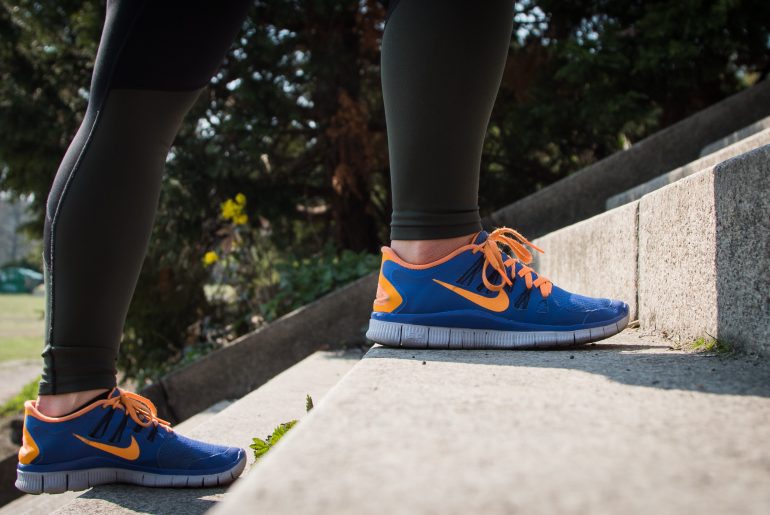A personal story of sitting less and moving more by Connor Soles Before coming to Queensland to study in the Doctor of Medicine program I considered myself an active person. I commuted by bicycle to my then-job as a medical scribe where I followed physicians into consultations and composed hospital charts on a mobile workstation. The hustle and bustle of the Emergency Department meant that I would cherish the rare moments that I would roll to a stop near the physicians alcove, cleverly positioned adjacent to the insta-coffee machine, and slump into a swivel chair to polish my notes. I had never experienced what it was like to be chained to a workstation seated, unmoving, for long periods of time before beginning medical school, and I’d never had to learn how not to be. In my newly (half) furnished apartment (in Brisbane) I found that I could not escape our IKEA table turned desk, which was the only assembled piece of furniture aside from the couch. As a medical student studying now consumed and overwhelmed the majority of my waking hours, that and maintaining my relationship with my fiance who had accompanied me to Australia, left little time for my…
Health Benefits of Urban Green Spaces
A recent article from the BBC contained a shocking statistic that the average American spends “90% of their time indoors.” Though only a survey of the United States, it’s not hard to imagine that across the globe westerners are similarly confined to our homes or places of work. But why should this matter? The author Phillipa Fogarty cites decades of research summing up how time spent outdoors has beneficial impacts on our blood pressure and mental wellbeing while also making us happier and more engaged at work. All we need to do is spend time walking or moving in nature. But before you pack your bags and head for the hills, there is evidence that the same benefits can be gained from just five minutes. The article goes on to say that when compared to indoor “relaxation” training or having a view of the outdoors, the benefits of time outdoors are greatest with short daily walks. So spend a few minutes in a local park on your way to work, as a group as part of a BeUpstanding team, or on your lunch break and bring the benefits of the great outdoors into your own backyard. This article was written…
Benefits of Walking to Work
By Anna Rasmussen On the 4th October it was Diabetes Australia Walk to Work Day. Walking has become an integral part of my daily routine. I spend between two and ten hours each week walking to and from destinations including university or the hospital where I study, the weekend markets, or the shops. The World Health Organisation has acknowledged active transport as a way to improve global environmental and health outcomes. My motivations are primarily to benefit my physical and mental health, but walking has other benefits such as being non-polluting, posing little danger to others, saving money, and, perhaps mostly importantly, I enjoy it. I am, however, one of the minority in Australia that uses walking as their main form of transit. The 2016 Census found that 69% Australian commuters travelled to work by car, and another 5% as car passengers, while 9% used public transport, 1% cycled, 4% walked, and 4% used multiple methods. This is largely consistent with rates from 2011, with a 0.5% rise in driving a car and a 0.7% increase in train use, while cycling and walking declined 0.1% and 0.3% respectively. Furthermore, infrastructure and culture is becoming increasingly car-centric. This is not to…
Achieving Social Change: How Programs Like BeUpstanding Make a Difference
BeUpstanding wants to help make workplaces everywhere more dynamic, active, and healthy. Built on a foundation of over ten years of research signalling the benefits of sitting less and moving more in the workplace, the BeUpstanding program was designed to change the way we work and think about our health for the better. But if we know that an “upstanding” workplace culture is a healthier workplace culture, how do we get the word out? And, maybe more importantly, how do we make it stick? Large scale behaviour change, like behavioural public health interventions, are understandably very difficult to implement—but here’s the gist. Firstly, we need to consider who we can help the most. Even though it would be great to help everyone affected, finding target populations of those particularly “at-risk” helps interventions target resources where there can be maximum benefit. Target populations are found during the research stage of program development, long before the implementation of an intervention. Our VicHealth review in 2012 helped to identify desk workers as a key target population. Obviously, the dangers of spending most of your day sitting affect everyone, but the BeUpstanding champion toolkit particularly targets workplaces and organisations. This is where sedentary behaviour…
Being The Best Champion For Your Workplace: Understanding The Psychology of Leadership
As a BeUpstanding champion, you will be leading your organisation in forming healthier habits and creating a dynamic workplace culture; but it’s no secret that taking on new leadership roles like this one can be daunting, especially if you feel as though you don’t fit the bill. Recent research suggests that just having self-doubt about your successes and leadership abilities may in turn stifle them. Findings from a study on the consequences of imposter feelings and self-doubt showed that they negatively impacted students’ ability to career plan and strive, and decreased motivation to lead in a professional working environment. Previous and more traditional psychology theories of leadership might perpetuate these imposter feelings by focusing on the “innate” qualities that all great leaders have, or a prescribed reward and punishment system that all great leaders use. For example, the Great Man theory of leadership is the idea that “leaders are born and not made”, possessing inherited qualities which make them better suited to lead (i.e. confidence or assertiveness). Transactional leadership theory, on the other hand, asserts that great leadership is determined by one’s ability to set expectations and enforce them with the effective use of rewards and punishments. These theories are…
An Exercise Regimen Everyone Can Squeeze In
The following article was written by Emmanuel Stamatakis and published in The Conversation on the 21st February 2019. Have you recently carried heavy shopping bags up a few flights of stairs? Or run the last 100 metres to the station to catch your train? If you have, you may have unknowingly been doing a style of exercise called high-intensity incidental physical activity. Our paper, published today in the British Journal of Sports Medicine, shows this type of regular, incidental activity that gets you huffing and puffing is likely to produce health benefits, even if you do it in 30-second bursts, spread over the day. In fact, incorporating more high intensity activity into our daily routines – whether that’s by vacuuming the carpet with vigour or walking uphill to buy your lunch – could be the key to helping all of us get some high quality exercise each day. And that includes people who are overweight and unfit. What is high intensity exercise? Until recently, most health authorities prescribed activity lasting for at least ten continuous minutes, although there was no credible scientific evidence behind this. This recommendation was recently refuted by the 2018 US Physical Activity Guidelines Advisory Report. The new…
Direct Healthcare Costs Of Sedentary Behaviour In The UK
The following press release originally appeared on the BMJ Newsroom and was published on March 23rd 2019. Spending large amounts of time sitting or lounging around during the day is linked to around 70,000 deaths per year in the UK and the NHS spends in excess of £0.7bn per year treating the health consequences, suggests research from Queen’s University Belfast and Ulster University published online in the Journal of Epidemiology & Community Health. A large proportion of the UK population have sedentary jobs and leisure activities, and official physical activity recommendations regarding sedentary behaviour are vague. Previous studies have shown that spending large parts of the day sitting down increases the risk of cardiovascular disease, type 2 diabetes, cancer and death and is a burden on health services. But no estimate of the financial impact that sedentary behaviour has on the NHS has been calculated, so the authors set out to do just that. Figures calculated by other researchers on the impact sedentary behaviour has on the relative risks of five specific health conditions (type 2 diabetes, cardiovascular disease, colon cancer, endometrial cancer and lung cancer) and deaths from all causes were combined with figures on the percentage of adults…
What Makes A Good Champion?
Are you interested in becoming a workplace champion? Maybe you are looking for someone to assume this role in your workplace but you are unsure where to start. You might ask yourself what makes a ‘good’ workplace champion? Previous research suggests that the most effective workplace champions are those who have a genuine passion for health and wellbeing and are enthusiastic about the opportunity to inspire others towards a healthier lifestyle (Healy et al., 2018). They must also be committed to making long-term positive health changes in their workplace and display a good relationship with their peers. It could be someone that has, or is eager to gain, some experience in managing similar projects. Health and safety representatives are often chosen for this position because it coincides with their goals, namely to create a safer, healthier workplace. However, we must also consider the individual’s capacity to adopt this role. Do they have the time and resources to engage fully with the program within the confines of their own job? Or will it fall into their periphery? These are just a few of the things that must be considered before electing a workplace champion. More general personality traits like outgoingness and…
Americans Are Sitting at Record Rates. Here’s Why That’s So Dangerous
The following article was written by Alice Park and was originally published by Time on April 23, 2019. Every day, we modern humans stay comfortably seated on our behinds for hours at a time: binge watching shows on Netflix, pecking away on keyboards at work, scrolling through social media feeds. But do people really sit more than they used to? That’s what Yin Cao and an international group of colleagues wanted to find out in their latest study published in JAMA. While studies on sitting behavior in specific groups of people — such as children or working adults with desk jobs — have recorded how sedentary people are, there is little data on how drastically sitting habits have changed over time. “We don’t know how these patterns have or have not changed in the past 15 years,” says Cao, as assistant professor in public health sciences at the Washington University School of Medicine. The researchers used data collected from 2001 to 2016 by the National Health and Nutrition Examination Survey (NHANES), which asked a representative sample of Americans ages five and older how many hours they spent watching TV or videos daily in the past month, and how many hours they spent…
How Much Do Sedentary People Really Need To Move? It’s Less Than You Think
The following article was originally posted by the Conversation on April 23, 2019 and was written by Emmanuel Stamatakis, Joanne Gale, and Melody Ding. People who spend much of their day sitting may need to move around less than we thought to counteract their sedentary lifestyle, new research shows. Our research, published today in the Journal of the American College of Cardiology, found about 20-40 minutes of physical activity a day seems to eliminate most health risks associated with sitting. That’s substantially lower than the one hour a day a previous study has found. We spend almost all our waking day sitting, standing, or moving. The health impact of each one of these can be complex. For example, too much standing can lead to lower back problems and even a higher risk of heart disease. But sitting for too long and not moving enough can harm our health. Then there are people who sit for many hours and also get in reasonable amounts of physical activity. For example, someone who has an office job but walks to and from work for 20 minutes each way and runs two to three times a week easily meets the recommended level of physical activity. While we know moving is better than…










